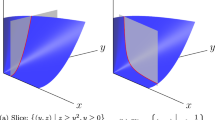Abstract
The solution of a particular nonconvex program is usually very dependent on the structure of the problem. In this paper we identify classes of nonconvex problems involving either sums or products of ratios of linear terms which may be treated by analysis in a transformed space. In each class, the image space is defined by a mapping which associates a new variable with each original ratio of linear terms. In the image space, optimization is easy in certain directions, and the overall solution may be realized by sequentially optimizing in these directions.
In addition to these ratio problems, we also show how to use image space analysis to treat the subclass of problems whose objective is to optimize a product of linear terms. For each class of nonconvex problems, we present an algorithm that locates global solutions by computing both upper and lower bounds on the solution and then solving a sequence of linear programming sub-problems. We also demonstrate the algorithms described in this paper by solving several example problems.
Similar content being viewed by others
References
Almogy, Y. and O. Levin (1969), Parametric Analysis of a Multi-Stage Stochastic Shipping Problem,Proc. of the Fifth IFORS Conference, Venice, 359–370.
Almogy, Y. and O. Levin (1971), A Class of Fractional Programming Problems,Operations Research 19, 57–67.
Cambini, A., L. Martein, and S. Schaible (1989), On Maximizing a Sum of Ratios,Journal of Information and Optimization Sciences 10, 65–79.
Charnes, A. and W. W. Cooper (1962), Programming with Linear Fractional Functionals,Naval Research Logistics Quarterly 9, 181–186.
Dinkelbach, W. (1967), On Nonlinear Fractional Programming,Management Science 13, 492–498.
Falk, J. E. and S. W. Palocsay (1992), Optimizing the Sum of Linear Fractional Functions,Recent Advances in Global Optimization, eds. C. Floudas and M. Pardalos, Princeton University Press: Princeton, New Jersey, 221–258.
Falk, J. E., S. W. Palocsay, W. J. Sacco, W. S. Copes, and H. R. Champion (1992), Bounds on a Trauma Outcome Function via Optimization,Operations Research 40, S86-S95.
Horst, R. and H. Tuy (1990),Global Optimization: Deterministic Approaches, Springer-Verlag: Berlin.
Jagannathan, R. (1966), On Some Properties of Programming Problems in Parametric Form Pertaining to Fractional Programming,Management Science 12, 609–615.
Konno, H. and M. Inori (1989), Bond Portfolio Optimization by Bilinear Fractional Programming,Journal of the Operations Research Society of Japan 32, 143–158.
Konno, H. and T. Kuno (1989), Linear Multiplicative Programming, Tokyo Institute of Technology Institute of Human and Social Sciences Technical Report IIISS 89–13.
Konno, H., Y. Yajima, and T. Matsui (1991), Parametric Simplex Algorithms for Solving a Special Class of Nonconvex Minimization Problems,Journal of Global Optimization 1, 65–81.
Konno, H. and Y. Yajima (1992), Minimizing and Maximizing the Product of Linear Fractional Functions,Recent Advances in Global Optimization, eds. C. Floudas and M. Pardalos, Princeton University Press: Princeton, New Jersey, 259–273.
Mangasarian, O. L. (1969),Nonlinear Programming, McGraw-Hill: New York, New York.
Ritter, K. (1967), A Parametric Method for Solving Certain Nonconcave Maximization Problems,Journal of Computer and System Sciences 1, 44–54.
Schaible, S. (1977), On the Sum of a Linear and Linear-Fractional Function,Naval Research Logistics Quarterly 24, 691–693.
Schaible, S. (1981), A Survey of Fractional Programming,Generalized Concavity in Optimization and Economics, Academic Press, Inc.: New York, 417–440.
Author information
Authors and Affiliations
Rights and permissions
About this article
Cite this article
Falk, J.E., Palocsay, S.W. Image space analysis of generalized fractional programs. J Glob Optim 4, 63–88 (1994). https://doi.org/10.1007/BF01096535
Received:
Accepted:
Issue Date:
DOI: https://doi.org/10.1007/BF01096535




